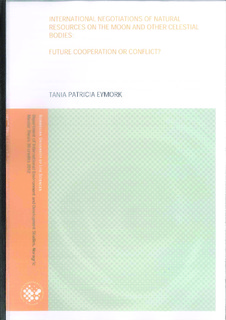| dc.description.abstract | This thesis aims to assess the degree to which one can expect conflict or cooperation over the natural resources on the Moon and other celestial bodies in the future. By describing and exploring how the emerging global space industry may benefit humankind, it covers existing
international space treaties and how fairer administration may help to eradicate poverty by, amongst other things, providing a clean source of environmentally friendly energy. This sixtyyear young industry is redeploying rapidly from once a total governmental responsibility and
concern to a more entrepreneurial, commercialized, and privatized sector, hence leading to competition between major space faring nations. Many of our daily activities today are highly dependent from space activities. Fossil fuels are becoming increasingly challenging to commercially exploit as new areas rich in oil and gas are found in harsher climates such as the Arctic and deeper waters. Due to expensive exploration and exploitation costs, only developed and rich countries will benefit
future access, whereas the Less Developed Countries may be left out and remain in
sustainable poverty. The alternative energy sector for renewable energy resources such as bioenergy, solar, wind and hydropower have their limits. Nuclear power is today a much debated. The Moon and other celestial bodies contain a vast amount of natural resources. One, and in abundance, is helium-3. It is estimated that forty tons can meet twenty five percent of the
global energy demand for one year. This clean, non-radioactive and safe source of energy scarcely exists on Earth. Helium-3 derives from the dismantlement of old and outdated nuclear warheads. Helium-3 is used within medicine, scientific research, and well logging operations1 in the oil and gas industry, and for homeland security. Major space nations such as
Russia, China, India, and Japan appear to have integrated within their space programs to commercially exploit the Moon for helium-3 in the future. The United Nations 1967 Outer Space Treaty (OST) prohibits any commercial exploitation on
the Moon and other celestial bodies2 and permits only scientific research for peaceful uses. The Moon and other celestial bodies including the Antarctica and the deep seas (including the Arctic) belong to the Common Heritage of Mankind (CHM). This raises issues whether or not new treaties will be required, and whether or not a new mandating body to be established. The
1 Hydrocarbon detection in rock formation
2 Excluding the planet Earth.
CHM is a principle within international law, which holds that defined areas such as the Moon and other celestial bodies, Antarctica, and the deep seas (including the Arctic) should be held in trust for future generations and be protected from exploitation. However, legal and much
debated legal loopholes exist.
The quest for profitable natural resources may often be a basis for conflict, and even wars socalled ‘resource wars’. ‘Space’ is also a resource, for example Low Earth Orbit (LEO) where satellites are positioned. Accordingly, conflicts among some nations are already in tension due to outdated LEO treaties where ‘first-in, first use’ principle is used. LEO is becoming quite crowded with satellites, and both nation states and private companies want to position
themselves in the best space. Another debate is the delimitation and demarcation of space; where does space start and even where does space end. Therefore, to which degree can one expect conflict or cooperation on the Moon or other celestial body if we cannot even set rules
for something as close as LEO ?
Clean energy is the most important challenge Mankind has to face3. Dr. Richard Smalley also fears for the world the shortage of affordable and achievable energy resources, which are a
necessity for stability in a global world. | no_NO |
